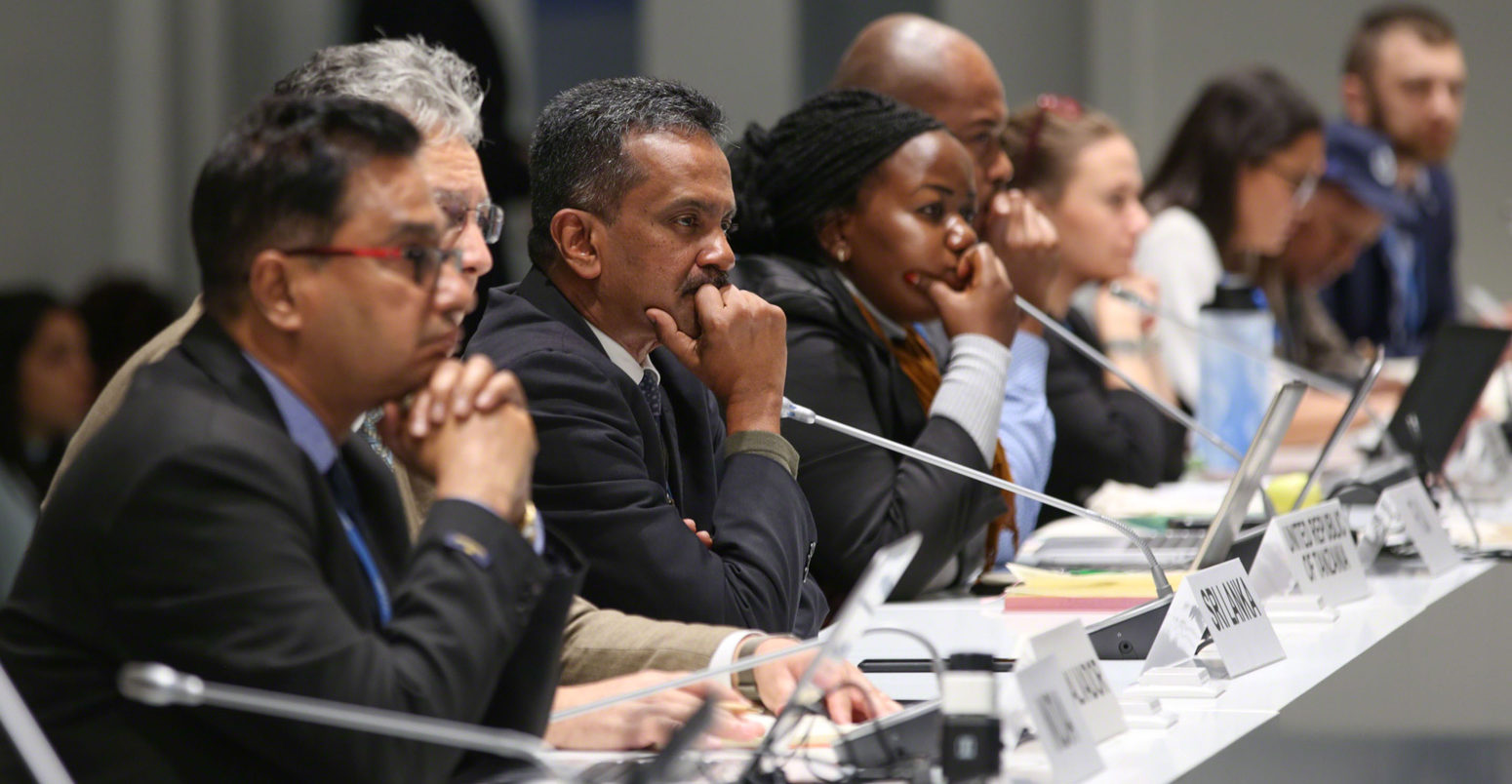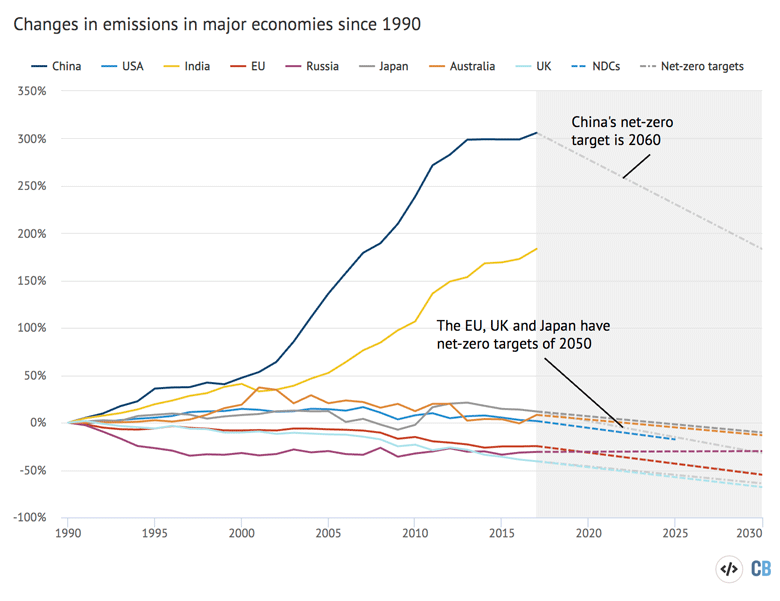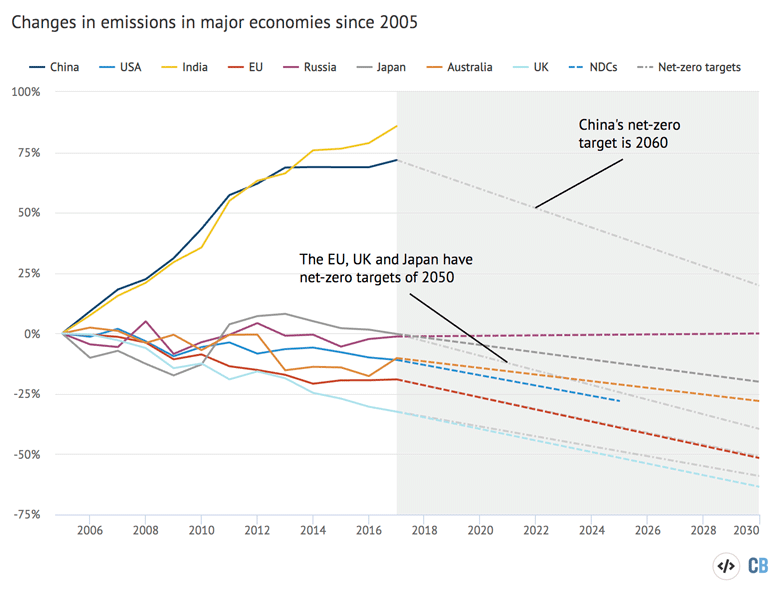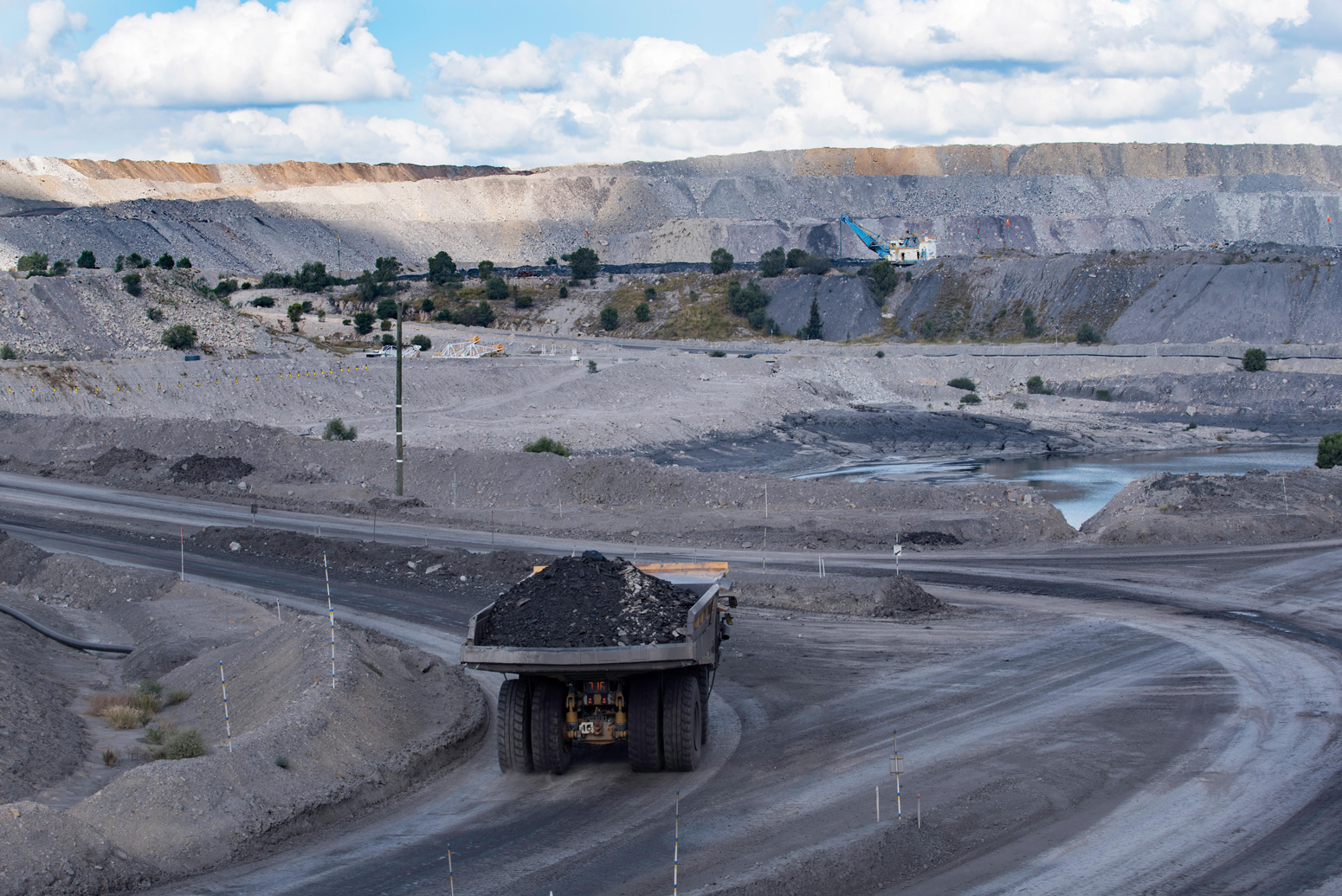
Analysis: Which countries met the UN’s 2020 deadline to raise ‘climate ambition’?
Josh Gabbatiss
01.08.21Josh Gabbatiss
08.01.2021 | 8:00amThe end of 2020 marked the moment, under the Paris Agreement’s “ratchet mechanism”, when nations were supposed to formally submit more ambitious commitments for cutting their emissions.
However, just 45 “parties” (44 countries, plus the EU’s 27 member states viewed as one bloc) met this deadline.
After a year disrupted by the Covid-19 pandemic, nations representing only around 28% of global emissions registered new or updated “nationally determined contributions” (NDCs) on the UN’s official registry by the end of the year.
Some big emitters did register their NDCs in time, including the UK and EU. But major absences included the US, India and China.
Even among the new submissions, many showed no increase in ambition since the first pledges made five years ago, or even backtracked with scaled-back proposals.
Here, Carbon Brief analyses the various new pledges and how they add up. However, one expert tells Carbon Brief that, while there was reason for hope among the new NDCs, the collective plans are still “totally off” what is required to achieve the Paris Agreement’s global warming targets.
- Why were new climate pledges expected in 2020?
- Which nations have announced new targets?
- Do the new pledges reflect an increase in ambition?
- How much climate finance has been requested?
Why were new climate pledges expected in 2020?
Every party that signed up to the Paris Agreement has to commit to a target for cutting its share of global emissions, known as its NDC, every five years.
In the run up to the COP21 climate summit in Paris, most nations had submitted intended nationally determined contributions (INDCs), which automatically became their first NDCs unless parties chose to submit updated versions.
A few countries like North Korea and Panama chose to hold off and submit their NDCs after ratifying the Paris Agreement.
According to the United Nations Framework Convention on Climate Change (UNFCCC), 190 parties, including the 27 EU member states, have now submitted first NDCs. A handful, including Iran, Iraq and Turkey have yet to do so.
Most of the pledges to reduce emissions within the NDCs were communicated as percentage reductions from a fixed baseline by a fixed year, although some, notably China and India, based theirs on cuts in “emissions intensity of GDP”. To add to the confusion, nations picked different starting points and target years.
Crucially, the initial round of INDCs was not enough to meet the climate targets set out in Paris, a point acknowledged at the time by world leaders.
Estimates suggest they would set the planet on a course for around 3C of warming, rather than the 2C or stretch target of 1.5C that nations had agreed in Paris in 2015.
Now, five years after the Paris Agreement was adopted, countries are obliged to renew and upgrade their NDCs. This is the first test of the “ratchet mechanism” embedded in the agreement, which seeks to scale up the ambition of pledges over time.
The chart below shows the progress some of the world’s major economies have made in cutting emissions from a baseline of 1990 – which is used by the EU and UK.
The coloured dotted lines indicate a linear trajectory of necessary further cuts to meet their NDC targets for 2030. China and India’s GDP-based NDCs are not show, but the light grey line indicates the progress China, the UK and the EU must make towards their net-zero targets.

This chart, meanwhile, shows the progress some of the world’s major economies have made in cutting emissions from a baseline of 2005, which is used by the US.

In line with the Paris Agreement, nations that only set an initial NDC covering the period up to 2025, such as the US, must now produce one that goes to 2030, and those that already contained a 2030 target must “communicate or update” their NDCs.
The agreement also states “the efforts of all parties will represent a progression over time” and will reflect the “highest possible ambition”.

However, as the text does not explicitly require new pledges to be submitted if they already run to 2030, there is room to interpret it as meaning that previous NDCs can be re-communicated. Adopting clearer language on the need for ambition was a contentious topic at COP25 in 2019.
“There is a legal dispute on what is allowed and what is not allowed, Prof Niklas Höhne from Climate Action Tracker (CAT) tells Carbon Brief, adding that nevertheless he sees it clearly:
“I would argue that in the last five years, for example, renewables have become much, much cheaper than they were projected five years ago, so the situation is completely different and every country can go back and check whether they can do a little bit more.”
Parties were initially asked in the decision text following the Paris Agreement to inform the UN of their new NDCs nine to twelve months before the COP26 climate summit in Glasgow so that the UNFCCC secretariat could prepare a synthesis report based on their contents.
Just three nations representing around 0.1% of the world’s emissions met this deadline.
This “symbolic” date was ultimately delayed after the Covid-19 pandemic led to the COP’s postponement.
Instead, the UNFCCC announced it would publish an initial version of the NDC report by 28 February 2021, based on the NDCs in its registry as of 31 December 2020. The report will then be updated with any new information closer to COP26.
While some nations expressed concerns about their capacity to assemble new NDCs by the end of the year, a letter written in August 2020 by UNFCCC executive secretary Patricia Espinosa made it clear that the end-of-year deadline was still considered important.
“I strongly encourage Parties to submit their updated or new NDCs in accordance with this timeline,” she wrote.
Which nations have announced new targets?
The table below shows the nations that heeded Espinosa’s advice and made their new announcements by 31 December 2020.
It also includes analysis from the World Resources Institute (WRI) of each nation’s share of total greenhouse gas emissions.
The EU, Russia, Brazil, Australia, Japan, South Korea, Argentina, Mexico, Zambia and the UK are the only economies each contributing around 1% or more of global emissions that have announced new targets.
However, as analysis by CAT indicates, some nations that met the deadline merely restated past commitments or made new ones that did not substantially increase ambition. (See section below.)
Many of the first countries to come forward with updated NDCs were small island states and other nations that are highly exposed to climate impacts, but contribute very little to global emissions. The Marshall Islands, for example, submitted its new NDC almost two years earlier than most other parties.
Also included in the table are nations that have indicated an intention to “enhance ambition or action in new or updated NDCs”, as recorded by the WRI’s Climate Watch resource.
This group contains an additional 82 nations, accounting for around 33% of total emissions.
Many of these commitments came from an announcement made at COP25 by 103 countries to “enhance ambition of their NDCs by 2020”.
China, the world’s largest emitter, remains the biggest omission from the table, although its leader Xi Jinping announced at a UN climate ambition summit in December that his nation would aim for carbon neutrality by 2060 and scale up its 2030 NDC in line with this. However, China has yet to formally register its new NDC with the UN.
China’s proposed NDC changes include a cut to the CO2 intensity of its GDP by more than 65% from 2005 levels, compared to its earlier target of 60-65%. While this marks an increase in ambition, it suggests that – in the short term and depending on assumptions about GDP growth – China’s emissions cuts will be modest. (See Carbon Brief’s analysis of China’s new 2030 pledge.)
Meanwhile, the US does not appear in the table above, although president-elect Joe Biden is expected to set out plans for a new NDC after he has taken office later this month and the US re-joins the Paris Agreement.
Other major emitters that have not come forward with new plans include India, Indonesia, Iran, Canada, Saudi Arabia and South Africa. Collectively, these six nations contribute around 17% of global emissions.
Do the new pledges reflect an increase in ambition?
Submission of a new NDC does not automatically mean a more ambitious commitment and commentators have pointed out that several of the plans released by large countries fall short of what is required.
At the “climate ambition summit” hosted online last month by the UN, UK and France to mark the fifth anniversary of the Paris Agreement, 45 nations came forward with enhanced NDCs.
According to Taryn Fransen, an international climate change policy expert at WRI, there has been a “mixed bag” so far, with the EU and UK in particular taking a “significant step up”.
She notes that a number of Latin American countries have also raised their ambition, including Argentina, Chile, Colombia and Peru.
Prof Niklas Höhne from CAT tells Carbon Brief that, while the situation is “much better” than he would have imagined six months ago, “it is still not sufficient”.
“We have several countries that have submitted the same thing or even [gone] backwards, so there’s still a lot to do this year…What’s very clear is that we are not a little bit off we are totally off when you add all the different pledges of countries.”
NDCs from major economies have been analysed by CAT to assess whether or not they represent an increase in ambition from previous commitments.
Lower ambition: Brazil and Mexico
Brazil has been the subject of extensive criticism for producing a new NDC that not only fails to raise ambition, but uses an accounting “trick” to make its initial pledge less ambitious.
The nation says it will cut emissions by 43% over the next decade compared to 2005 levels, the same as its previous proposal.
However, methodological changes in the emissions inventory since the first pledge was made mean this is now a considerably higher starting point.

The Climate Observatory, a Brazilian NGO, estimates this would mean an additional 400m tonnes of CO2e (MtCO2e) being released in 2030 compared to the original 2015 plan. As of 2017, Brazil’s total annual emissions were around 1.4bn tonnes of CO2 (GtCO2).
The nation has also mentioned a potential 2060 net-zero goal, but said this is conditional on the payment to Brazil of $10bn per year in climate finance by other countries.
In a critique of the government’s plans, WWF says this request comes “despite [Brazil] being one of the 10 largest economies in the world”.
As a result, CAT has downgraded Brazil’s NDC from “insufficient” for meeting Paris goals to “highly insufficient”. President Jair Bolsonaro was also excluded from the recent climate ambition summit due to his nation’s insufficient plans.
Fransen says Mexico has similarly submitted a new pledge, based on a business-as-usual baseline, that is weaker than its original NDC.
“In the updated NDC they have revised those [baseline] projections upwards which of course means their achieving their target will result in higher 2030 emissions than it would have before,” she says. The NDC has also got rid of a reference to emissions peaking in 2026.
Lacking ambition: Russia and Vietnam
Russia states in its new NDC that it “demonstrates an increasing ambition compared to earlier commitments to limit greenhouse gas emissions”.
Its previous submission from 2019 contained a commitment to cut emissions by between 25-30% of 1990 levels by 2030. The new one pledges to cut emissions by 30%. (Russia was one of the last nations to submit a first NDC, having only ratified the Paris Agreement in October 2019.)
But the ambition of this NDC is debatable given Russia’s emissions have already fallen by more than 30% since 1990.
Following the end of the Soviet Union in the early 1990s and the restructuring of the economy, the nation’s emissions dropped dramatically. But, in recent years, its emissions have been growing.
“[Russia] is basically proposing a target that would be met anyway,” says Höhne. He adds that Vietnam is also using a similar strategy.
According to CAT, Vietnam is set to “vastly overachieve its updated NDC”, as the business-as-usual emissions trajectory it is based on has been “hyper-inflated”, meaning no new policies will be required to achieve it.
Same ambition: Australia, Japan and others
Australia has faced criticism for submitting a “new” NDC without a substantial change to the old one. Therefore, it has been deemed “insufficient” by CAT.
While the new NDC states that it represents a “floor on Australia’s ambition” and that the nation “is aiming to overachieve”, energy minister Angus Taylor has said there are no plans to make a more ambitious pledge in the near future.

Other nations that have similarly made no significant changes include Switzerland and Singapore.
Japan, South Korea and New Zealand, having re-submitted their original NDCs with unchanged targets, have all announced plans to reappraise their submissions in 2021 and come forward with stronger pledges.
For the two east Asian nations, this news comes after their governments revealed plans to aim for net-zero emissions by 2050, commitments that will require new shorter term targets as well.
“I think that is a good sign of the Paris Agreement working…governments feel pressured to say ‘OK we need to do more’,” says Höhne.
How much climate finance has been requested?
Every nation that has signed up to the Paris Agreement is expected to cut its emissions, but there is an expectation that poorer nations will be helped by aid – known as “climate finance” – from richer ones.
Financing climate action is, therefore, an important component of many NDCs.
Reflecting the varying levels of detail in the NDC documents, some parties have provided precise figures for their financial requirements, while others are more vague.
The table below shows explicit mentions of international climate finance requests included in the new round of NDCs, as well as plans for domestic funding. (Carbon Brief produced a similar table of requests for international funds in the first round of NDCs in 2015.)
In the latest round, a total of $373bn in international climate financing has so far been requested by developing nations. A large chunk of this is the $236bn quoted by Ethiopia.
However, as Carbon Brief stressed in its 2015 analysis of finance requests, there are important caveats to consider when looking at the total figure. For example, the types of requests can be very varied and often not directly comparable.
Some NDCs mentioned sums of money, but did not specify whether the funds they required would be sourced domestically or internationally.
Many countries that did not include specific numbers made it clear their targets depended on some level of financial support from other countries.
Nations agreed in 2009 that they would provide climate finance of $100bn a year by 2020, primarily through the UN-backed Green Climate Fund (GCF).
The GCF has often struggled to raise enough money from richer nations. The only country that makes a specific reference to providing money to the fund in the new NDCs is Monaco.
More detail on international financial requirements will likely be revealed as more NDCs emerge in the coming months.
Fransen tells Carbon Brief that a trend she has seen with the latest NDCs is that the sums being requested are “much more robust” than the previous round. “Countries have just had a lot more time to build their capacity,” she says.
-
Analysis: Which countries met the UN’s 2020 deadline to raise ‘climate ambition’?
-
Analysis: Which countries raised their ‘climate ambition’ in 2020?

